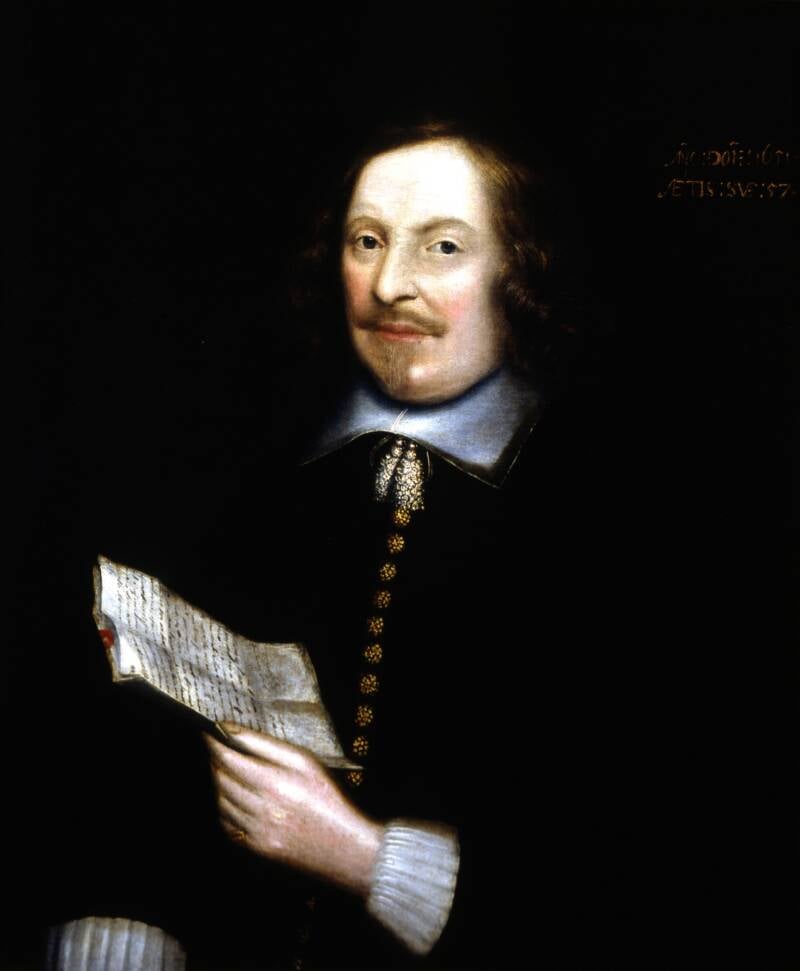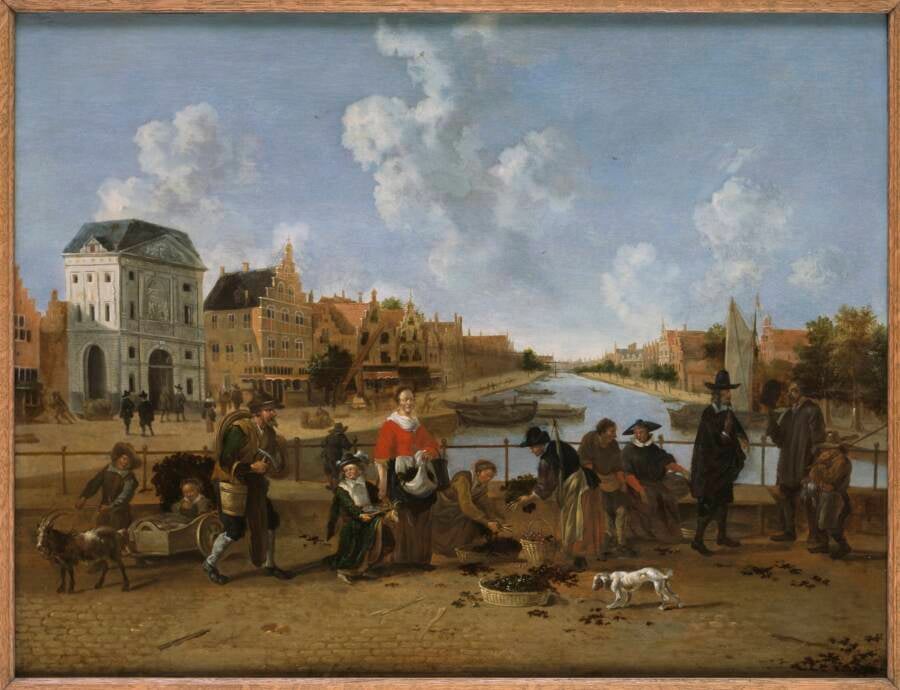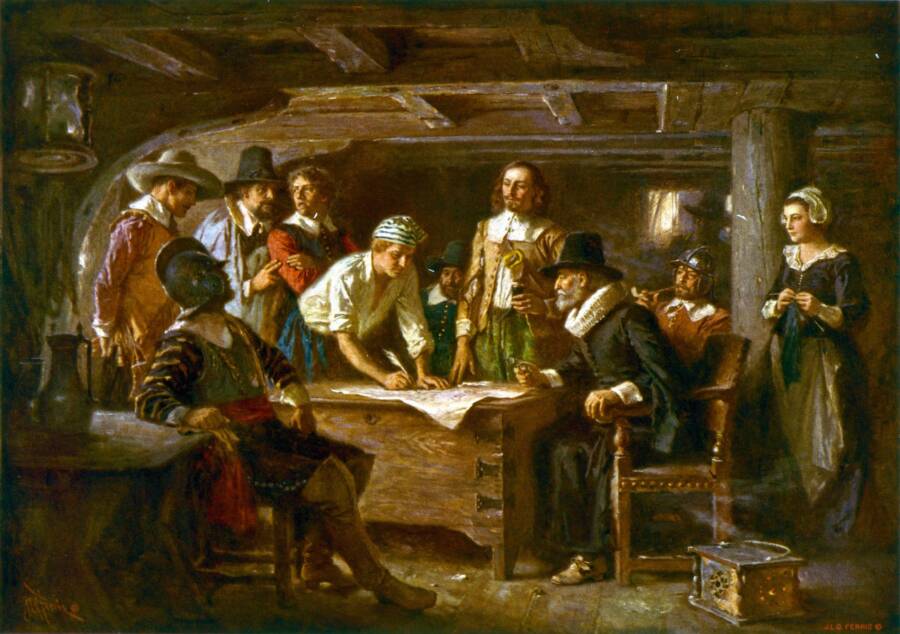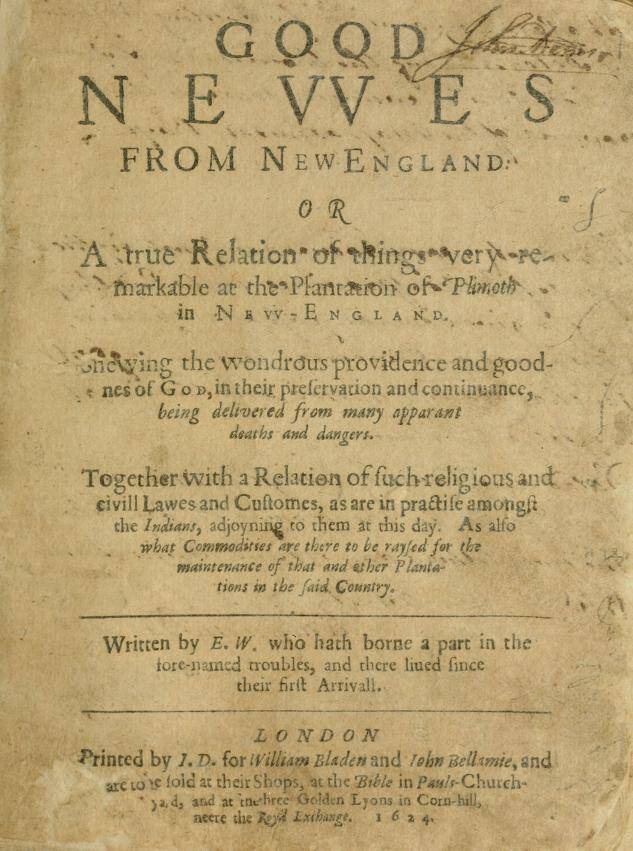Edward Winslow was not only a passenger on the Mayflower and one of the first governors of Plymouth Colony, but he also played a crucial role in maintaining relationships with the local Wampanoag people.

Public DomainEdward Winslow played an essential role in the survival of Plymouth Colony, but ultimately met a tragic end.
In 1623, word reached the settlers of Plymouth Colony that the Wampanoag leader Massasoit had fallen ill. The colonists had struck a peace deal with Massasoit in 1621, and so Pilgrim leader Edward Winslow decided to tend to Massasoit in his hour of need.
Winslow not only reportedly walked 40 miles to Massasoit’s side, but nursed him back to health with chicken soup. This gesture of kindness helped deepen the colonists’ relationship with the Wampanoag people — and it’s far from the only thing Winslow did to help the struggling colony survive.
Intelligent and energetic, Winslow was one of the leaders of Plymouth Colony. He acted as the colony’s governor, wrote several first-hand accounts of the Pilgrims’ difficult early years, and became a fierce defender of the colony’s interests. Winslow, who suffered his fair share of tragedy, also became the first Englishman to get married in Plymouth Colony.
But Winslow’s story — and his tragic death at sea in 1655 — has been largely forgotten. Here’s everything you need to know about Edward Winslow, one of the Pilgrims who ensured the survival of Plymouth Colony.
A Circuitous Journey To The New World
Born on Oct. 18, 1595 in Droitwich, England, Edward Winslow’s path to the New World was circuitous. Though Winslow’s family was involved in the salt production trade, Winslow chose to pursue an education. He attended the King’s School (where Winslow probably studied grammar, Latin, and Greek) and may have also gone to university at Cambridge.
Winslow then got an apprenticeship with a printer in London. But rather than inspire his printing career, his apprenticeship seemed to have inspired his wanderlust. After flipping through a travel memoir written by an Englishman, Winslow decided to travel around Europe.
In 1617, Winslow fatefully made his way to Leiden in the Netherlands, where he crossed paths with members of the English Separatist church. These “Separatists,” who had fled religious persecution in England, would later be known as “Pilgrims.”

Public DomainA scene from Leiden from around 1660. The Pilgrims set sail from the Dutch city in 1620.
Before long, Winslow joined their ranks. He married a fellow Separatist, Elizabeth Barker, and helped the group with their underground printing activities. Winslow was also instrumental as the Separatists planned their journey to the New World. And in September 1620, he became one of the 102 people to sail west aboard the Mayflower.
The Perilous Mayflower Voyage

Public DomainDuring the 66-day crossing, the Mayflower encountered several fierce storms, one of which was so powerful that a young man was swept overboard.
Edward Winslow and the Pilgrims faced a difficult journey to the New World. They had departed England late, which meant that they encountered rough seas, and landed in Massachusetts instead of their intended destination of Virginia.
As the ship drifted offshore, several economic migrants who’d accompanied the Pilgrims argued that this meant that they weren’t bound to English law, which had been enacted in Virginia but not Massachusetts.
Some of these migrants, Pilgrim William Bradford darkly wrote, made “discontented and mutinous speeches.”
To establish rule of law, 41 men — including Edward Winslow — drew up a charter known as the Mayflower Compact. The document bound the signers to obey the laws of their colony, and stands as the first document created by Europeans in the New World to establish self-government.

Public DomainThe signing of the Mayflower Compact.
The Pilgrims then went ashore in southeastern Massachusetts, where they established Plymouth Colony roughly 40 miles south of present-day Boston.
“Falling in with Cape Cod, which is in New England, and standing to the southward for the place we intended, we met with many dangers and mariners put back into the harbor of the Cape, which was the 11th of November, 1620,” Winslow wrote of their arrival, according to a 2016 Smithsonian article. “Where considering winter was come, the seas dangerous, the season cold, the winds high and being well-furnished for a plantation, we entered upon discovery and settled at Plymouth: Where God please to preserve and enable us.”
But though they’d survived crossing an ocean, things were no easier on land.
Edward Winslow’s Role In The First Thanksgiving
During their first couple of months in the New World, dozens of Pilgrims suffered from conditions like pneumonia and scurvy and died. Forty-five people out of the original 102 perished during that first winter, including 14 of the 19 women aboard the Mayflower. These included Winslow’s wife, Elizabeth. Winslow subsequently married his fellow Pilgrim Susanna White in May 1621. They were the first couple to be married at Plymouth Colony.
By then, the Pilgrims had also started communicating with the Native Americans. In March 1621, a man named Samoset approached the colony. Having learned English from fishermen in his native Maine, Samoset greeted the Pilgrims in their language. Samoset and Squanto, who also spoke English, then introduced the colonists to Massasoit, leader of the local Wampanoag people.

Public DomainSamoset was the first Native American to approach the Pilgrims. He introduced them to Massasoit, with whom Edward Winslow would develop a friendship.
Winslow studiously recorded his interactions with the Wampanoag people. In fact, most of what we know about the first Thanksgiving in 1621 comes from just a few lines of a letter Winslow wrote, wherein he detailed a harvest celebration in which the Pilgrims and the Wampanoag feasted together for three days:
“Our harvest being gotten in, our governor sent four men on fowling, that so we might after a special manner rejoice together, after we had gathered the fruits of our labors; they four in one day killed as much fowl, as with a little help beside, served the Company almost a week, at which time amongst other Recreations, we exercised our Arms, many of the Indians coming amongst us, and amongst the rest their greatest king Massasoit, with some ninety men, whom for three days we entertained and feasted, and they went out and killed five Deer, which they brought to the Plantation and bestowed on our Governor, and upon the Captain and others. And although it be not always so plentiful, as it was at this time with us, yet by the goodness of God, we are so far from want, that we often wish you partakers of our plenty.”
An Important Plymouth Colony Leader
Edward Winslow is perhaps best known for developing a strong, even “tender” relationship with Massasoit. He and other colonists worked with the Wampanoag leader to establish a peace treaty in 1621. Later, when Massasoit got sick, Winslow went to his village to help take care of him.
In return for Winslow’s kindness, Massasoit declared the English settlers his “friends.” When he learned that some neighboring Native American warriors planned to attack the colony, Massasoit quickly alerted the Pilgrims.
Edward Winslow supported Plymouth Colony in other ways as well. He served as governor three times (in 1633, 1636, and 1644), worked with the surrounding colonies, and helped document the colony’s early days in Mourt’s Relation and Good News from New England. In texts like these, Winslow defended the colony and encouraged more settlers to sail to the New World.

Public DomainA copy of Good News from New England written by “E.W.” — Edward Winslow.
Plymouth, he wrote, was “not laid upon schism, division or separation, but upon love, peace and holiness; yea, such love and mutual care of the Church of Leyden for the spreading of the Gospel, the welfare of each other and their posterities to succeeding generations, is seldom found on earth.”
But Winslow also spent a great deal of time away from the colony, mostly sailing between the New World and England. And it was during one such voyage that he lost his life in 1655.
Edward Winslow’s Tragic Death At Sea
Edward Winslow’s work in Plymouth Colony had not gone unnoticed back in England. After Oliver Cromwell became Lord Protectorate following the English Civil War (1642-1651), he tapped Winslow for a number of important posts. And in 1655, Cromwell made Winslow the governor of Jamaica. But during his voyage to the island, Winslow fell ill. He died at sea at the age of 59.

Elliott Brown/Wikimedia CommonsA statue of Edward Winslow in his hometown of Droitwich, England.
Since then, Winslow left behind a largely positive legacy. He did great things for Plymouth Colony: Winslow was a backbone for the settlement during its early days and helped establish strong relationships with the Wampanoag people. He was also curious and friendly toward Native Americans — though he never saw them as “equal” to the white settlers.
But after Winslow’s death — and under the governorship of his son, Josiah — relations between the colonists and Native Americans deteriorated into violence. And Edward Winslow has become something of a footnote to the larger Mayflower and Plymouth Colony story.
Perhaps he’s seen as a minor character now, but Winslow played a central role in the story of Plymouth from the beginning. Back in Leiden he helped publish pamphlets; on the ship, he signed the Mayflower Compact; and as one of the Pilgrims of Plymouth, Edward Winslow played a crucial role in establishing relations with local Native Americans. Without his intelligence, curiosity, and warmth, history could have gone in a different direction.
After reading about Edward Winslow and how he ensured Plymouth Colony’s survival, see how settlers like the Pilgrims brought devastating diseases to the Indigenous people of the New World. Or, go inside the true story of the first Thanksgiving that you didn’t learn in school.





